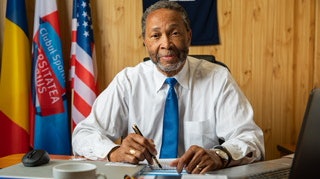The higher education establishment appears to be on the ropes. While the academy was once generally perceived as a fundamental bedrock institution of American society, public support for higher education has dramatically eroded, and in some circles, the approval level has plummeted well below 50%. On its cover page, the annual education issue of the New York Times magazine uses the sardonic headline, Not U, to capture the current attitude of parts of the country toward higher education. The headline is then followed by this intriguing subtitle: Why do more and more Americans think college isn’t even worth it?
 Dr. William B. Harvey
Dr. William B. Harvey
Still, it's important to remember that, within the academy, realizing fair treatment, justice, and equality for all Americans as a desirable and justifiable social pursuit is actually a recent occurrence. A mere six decades ago and prior to the civil rights movement, higher education was remarkably comfortable in its support of the status quo, which at the time was firmly anchored within a white supremacist patriarchy. Rampant racial discrimination and gender disparities throughout society were not only overlooked, they were often supported by colleges and universities. It took the focused, unyielding activism of people of color to ultimately embarrass institutions of higher learning into changing their perspectives and outlooks.
When affirmative action was introduced to provide greater access and opportunity to individuals from underrepresented groups, it was grudgingly accepted in the academic community and the administrative offices that were created to facilitate its implementation had little clout, and even less power. Critics of this modest approach to addressing centuries of unequal treatment quickly moved to undermine its moral validity by calling it an intrusion into long-standing academic processes and traditions. Despite, or perhaps because of, its profoundly modest record of success in increasing the presence of people of color among the student bodies and faculties of predominantly white institutions, affirmative action was appended onto the administrative structures of the higher education enterprise. Then, as the 21st century dawned, the push for affirmative action in higher education eventually morphed into support for DEI — diversity, equity, and inclusion. This transition followed the lead of the corporate community, which recognized and responded to the changing demographic character of the American population as the percentages of people of color continued to increase.
So now, as the nation becomes increasingly pluralistic and the percentage of European Americans has ceased to be the majority, conservative ideologues have used coercive techniques in conjunction with various political maneuvers to demand that colleges and universities renounce their previously articulated “core values” — such as curricular authority, academic freedom, faculty tenure, and of course, DEI. These reactionaries strive to restrict the opportunities available to historically underserved groups to receive the enlightenment and preparation for leadership that colleges and universities provide. While the response of the higher education hierarchy to these organized attacks has been underwhelming to date, perhaps some encouragement might be derived from a phrase attributed to English economist Thomas Malthus, who makes the argument that demography is destiny.
With each passing day, America becomes an increasingly pluralistic nation whose future economic development, political stability, and social progress will be irrevocably tied to the optimum development of individuals from those groups that have been systematically underserved. From both practical and moral perspectives, the academy has an obligation to demonstrate the efficacy of positive pluralism through its own policies and practices, and to challenge the nation to move expeditiously toward the realization of its articulated-but-unrealized ideals. Consider how different America might be today if in the early days of the 20th century, instead of taking an ivory tower, hands-off approach to the glaring racial and gender disparities in the society, the higher education community had used its resources, expertise, and social status to conceptualize a pathway toward liberty and justice for all.
America’s pluralism is its greatest asset. In the past, the higher education community has been complicit in its support of systemic racism, and now it has an opportunity to impact public opinion and cultivate support for positive pluralism among both the general public and the nation’s future leadership. If that happens, the country might finally be able to implement the spirit of the motto that it selected to place on its currency: e pluribus unum, meaning out of many, one. One people. One nation. One destiny.
Dr. William B. Harvey serves as Distinguished Scholar at the American Association for Access, Equity and Diversity in Washington, DC.






















